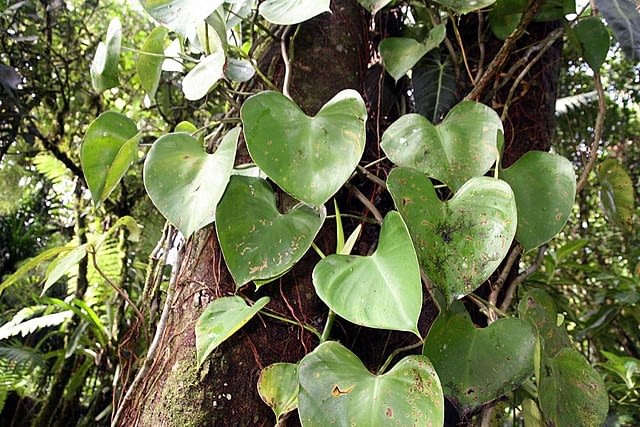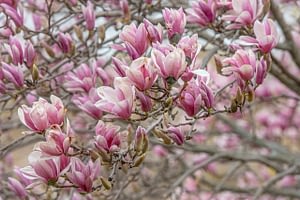
The Philodendron Melanochrysum is a charming and appealing tropical plant. The plant has dark green crystalline leaves that display a bright yellow vein.
It has yellow vein follow the way through the leaf to form a particular pattern. The leaves look are similar to the specks of gold. As the definition of “Melanochrysum” that means “black gold”.
It is part of the reason why it is called the “Black Gold Philodendron”, and it is a climbing vine plant.
The origin of the plant is Central-America and South-America.
Philodendron Melanochrysum plant profile
1. Common name
Philodendron Melanochrysum also has a scientific name of Philodendron Andreanum. The plant has a common name the Black Gold Philodendron.
2. Size
The Philodendron Melanochrysum plant can grow up to six to eight meter in its natural environment. If you grow the plant as a houseplant, it can grow up to three meters.
When you want to select a location for the plant, you have to remember that the plant can reach a height of up to 3 meters. It is recommended that you provide enough space, climbing and creeping help.
You can use rough-barked moss sticks or branches, or another type of creeping helps from nature. The plant will be happy to be located that is similar to rain forests, no direct sun, and half-shaded.
In rain forests, there is a small amount go light.
3. The soil
The Philodendron Melanochrysum plants like to have well-draining soil, rich, and loose potting soil that contains high organic matter. The plant can grow in sphagnum peat moss.
They are prone to wet feet that can cause Bacterial Leaf Spot, root rot, and fungal diseases. You have to make sure the soil to drain excess water out through the drainage holes in the plant’s container.
With the drainage hole, the soil should still hold water to hydrate the Philodendron Melanochrysum plant.
The best soil for Philodendron Melanochrysum plant is sphagnum peat moss because it is airy enough to drain water. Sphagnum peat moss is organic matter which makes the Philodendron Melanochrysum plants do the best.
But still, you must be careful when watering the plant because it can sometimes hold too much water. To solve this problem, you can use a hydroponic net pot.
This pot will provide more space for water to escape. It speeds up evaporation so all that water will not sit in the moss for a longer time.
It is recommended to avoid using dry and sandy potting mixes.
4. Light requirement
Philodendron Melanochrysum plant thrives well under low light conditions. The low light condition is the best aspects of their versatility.
Philodendron Melanochrysum plant that receives indirect light or medium-light will eventually produce more leaves and grow faster. That is why the plant should not be placed in direct sunlight if you want it to thrive well.
You are recommended to provide bright light, dappled light, similar to be under a tropical canopy. The plant can be acclimated to direct sunlight in the right conditions, but they thrive well in light shade.
If you see the leaves turning yellow, it is a sign that you are providing the plant too much direct light. On the other way around, the plant is getting leggy, the plant may need more light.
5. Humidity
Philodendron Melanochrysum plant likes humidity. It is recommended to maintain the humidity around the plant.
You can do this by providing a pebble tray of water. Mist them routinely during the growing stage. Or you can schedule to mist the plant about every two days.
During the winter, you are required to mist the plant every two to four days. The plant can do well under any humidity level, but moist air will assist to larger leaves and faster growth.
6. Temperature
Philodendron Melanochrysum plant requires warm temperatures and high humidity. During the night, the temperature should be around 65 to 70 degrees Fahrenheit.
However, the temperature range is variable, but no Philodendron Melanochrysum plant likes going below 55 degrees Fahrenheit for an extended period. The best average home temperature for the Philodendron Melanochrysum plant is 65°F to 75°F.
How to grow and care for Philodendron Melanochrysum plant
You have to remember that the Philodendron Melanochrysum plant originates in tropical regions. The plant will grow best if you can mimic that environment.
Care the Philodendron Melanochrysum plant with moisture, plenty of warmth, and bright light. These plants will survive best indoors.
1. Fertilizer
Philodendron Melanochrysum plant will be healthy and produce larger leaves if you feed the plant regularly. The best fertilizer for the Philodendron Melanochrysum plant is slow-release fertilizer pellets.
It is recommended to provide the slow-release fertilizer at the beginning of the growing season. Another method is to feed the plant every week with liquid fertilizer.
The plant should be fertilized every month with a half-strength solution in the summer months and the spring months. During the winter and fall, you need to feed the plant once per month.
You can also feed the plant every three to four months. You should always inspect the plant because you should fertilize when the plant is actively producing new leaves.
Indoors Philodendron Melanochrysum plant should be fed every two weeks in spring and summer. Feed them monthly in fall and winter with a balanced liquid fertilizer.
You can consider a 20-20-20 fertilizer that is appropriate for foliage plants. With the fertilizer, the plant can produce a large flower surrounded by a white hoodlike spathe. To encourage blooms indoors, use a high-phosphorus fertilizer, like a 15-30-15 fertilizer.
Outdoors Philodendron Melanochrysum plant will not require fertilizer in the planting hole. As new growth starts, you can apply 1/4 pound of a balanced NPK granular fertilizer with magnesium, and that receives at least 20 per cent nitrogen from an organic source.
Re-apply every two months or eight weeks for the first year. Slowly increase the amount of fertilizer per application to one pound.
Apply only two to three times in its actively growing stage.
2. Watering
The Philodendron Melanochrysum plant needs lukewarm water. Any stagnant rainwater is suitable for the plant.
You can fill a watering can and let it stand for at least two days during the rainfall. The water should be room-tempered and should not be cold and coming from the faucet.
The best condition is moist soil without too much water. They also do not like to dry out and always happy if their leaves being sprayed.
In the summer or warmer months, watering can take place every two days, while in colder months do it in every three or four days. It is recommended to keep the growing medium moist at all times.
Keeping the indoor Philodendron Melanochrysum plant moist during winter, where the air can get very dry can be hard to do. Avoid overwatering to prevent root rot that may develop. If you notice the leaves are drooping, it is a sign of either too much water or not enough water.
3. Re-potting the Philodendron Melanochrysum plant
The Philodendron Melanochrysum plant needs repotting as the plant outgrow their pots. The potted plant should be planted in well-aerated soil for easy drainage.
They should be re-potted especially when the plant become root-bound. Re-pot every two to three years. If you pot them in smaller pots, it helps prevent over-watering.
The most important thing is that the pot should be porous and contain a drainage hole. You can place Philodendron Melanochrysum plant in a terracotta pot inside a decorative pot.
Using pebbles in the bottom of the decorative pot will help keep the plant from sitting in water.
4. How to prune Philodendron Melanochrysum plant
The Philodendron Melanochrysum plant may be happy as table plants, hanging plants, or trailing plants. No matter which style you select, pruning your plant routinely will keep your plant lush and full.
If you notice leggy trails, this condition should be cut just after a node. You can prune these leggy trails to encourage new growth and promote bushiness.
Prune smoothly rather than jagged cut. Use your fingernails, scissors, and pruning shears. Pinch off the new growth to retain the plant manageable and re-pot them every year as the plant outgrow their pots.
If the Philodendron Melanochrysum plant grows too much, you can prune without any problems. The ideal period of pruning is from spring to late summer months.
If shoots that are too long, they can be shortened with a sharp knife or use garden shears.
5. Propagating the plant
The Philodendron Melanochrysum plant can be propagated well with top cuttings. All you have to do is to cut off a few cuttings under the leaf node. It is recommended to do the propagation in the summer and remove all leaves.
Place the cuttings into a mixture of sand and turf or compost. Put each of them into its new pot.
The soil should be sealed with a plastic bag and should be well-watered. The new pot requires average room temperature and a bright location but not directly under the sunlight.
It should be aired every two days to avoid mould formation.
These cuttings will be taken root after three or sometimes four weeks. The plastic bag must not be removed before the three weeks.
A successful propagation means that the cutting should be green and growing slowly. If the cutting is brown and dry, this means it will not have taken root.
The successful propagation can be in the open air and should be fed every four weeks.
